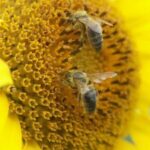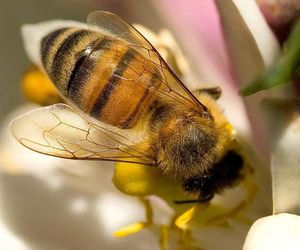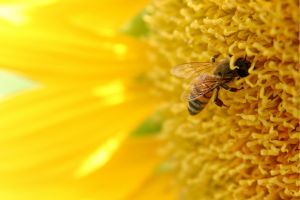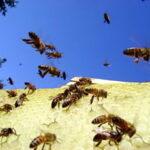In 2006, something was noticed by beekeepers here and around the world. The honey bee was disappearing. And it was happening at such a rate that it left many of them scratching their heads in wonder. It wasn’t just a few bees that come up missing, it was 50 to 90% of them! Hives that were once filled with bees were now empty and some had just the queen and a few of the brood (immature bees) no workers, and no one knew why or what was happening.
The honeybee is one of the biggest pollinators in the world and is needed to pollinate many of our food crops including fruits, vegetables and nuts. They pollinate over 90 different commercial crops and their disappearance has left farmers in a state of panic. According to the USDA, honey bees pollinate about one third of the human diet and is responsible for $15 billion and up of crop value.
Many farmers and orchard keepers have begun to truck in bees so that they would be able to pollinate the crops from other locations because there isn’t enough bees left in their area to do the job. This has left the bees in quite a state of stress and have caused many of those bees to die off as well.
As of July of 2008, 35 states have been affected. By this fall, who knows.
What is the cause? No one seems to know. The EPA and agricultural science community is looking into CCD to try to figure everything out. Even now the scientists are shrugging their shoulders and running more tests as we speak.
There are many theories out there that they think may be the cause:
1.) The varroa mite which is a pest of honey bees. They attach themselves to the bees to feed off their blood.
2.) New or emerging diseases like Israeli Acute Paralysis virus (IAPV) A distructoviris that can be transmitted through the varroa mite and was found in 96.1% of samples. The bees with this virus exhibit strange behavior like twitching wings outside of the hive and loss of worker bees from the hive. This may be throwing off their systems enough to get lost between the source of food and the hive.
3.) Pesticide poisoning from pesticides we put on crops, in-hive insect control, and mite control. The EPA has already found that nicotine based pesticides are detrimental to honey bees.
4.) Potential immune-suppressing stress on bees brought on by a number of factors including, drought, poor nutrition, and migratory stress brought on by having to move the bees long distances to pollinate crops.
The scientists are looking at the stress theory, the closest right now, although CCD may be caused by a number of factors.
Keep in mind this isn’t just happening here but all over the world Germany, the UK, France, and China, just to name a few. This is a global problem, and one we must take seriously.
Germany has banned a family of pesticides called neonicotinoid because on 99% of the bees tested they found a build up of clothianidin. Clothianidin is a chemical is produced by Bayer CropScience and is sold all over Europe under the trade name of “Poncho”.
Clothianidin, like the other neonicotinoid (nicotine based) pesticides that have been temporarily suspended in Germany. What this family of chemicals does is work its way up the plant and attacks the nervous system of any insect that comes into contact with it including honey bees. The EPA states that they feel that this isn’t the cause of CCD but will monitor the case in Germany to learn more about it.
In China people have taken to the fields with feather dusters in an attempt to pollinate the crops because the drop of honey bees is so drastic there.
What is being done?
The USDA has set up a steering committee to find the cause and try to stop CCD before we lose all the honey bees, which includes
1.) survey/data collection to determine honey bee health and the current status of CCD
2.) analyzing bee samples to determine what has killed them including pests, chemicals and stress factors.
3.) research on the 4 mentioned factors named above
4.) Mitigative/Preventive Measures to improve bee health and habitat and to counter mortality factors. including vitamin-enriched food, called super food, for their transportation to the next job.
The EPA is working on pesticide testing on it’s effects to the bees and their contributing factors to CCD. So far there has been many pesticides found in the pollen, the ones found goes from the most frequent to less: Fluvalinate, FluvalinateCoumaphos, Chlorpyrifos, Endosulfan 1, Atrazine, and Fenpropathrin. This is the top 6 only of 19 that was found. It has been about 17 years since any pesticides have been banned in the US. I have a feeling we are long overdue and now maybe just maybe we will see such a ban.
What can we do?
One thing is to cut back on the amount of pesticides used. You can plant, and encourage the planting of good nectar sources such as red clover, foxglove, bee balm, and joe-pye weed. plant organically. It seems in most cases that organic honey bees aren’t being affected. We can also keep track and report the number of honey bees that you have seen to help keep a record of how well the honey bee is doing.
The cause has to be found as to why this is happening to the honey bee before a cure can be found. They have also come up with a strong vitamin filled nectar to try to strengthen them so that it can be used while transporting the bees to do the pollination locations. They hope this will help so that the bees aren’t so stressed after transportation.
If we can’t find out what is going on and try to do our part in saving the honey bee, we may wake up and find that they have gone extinct and where would we be without them?
Sources :
EPA www.epa.gov
USDA Steering committee report on CCD and its affects






